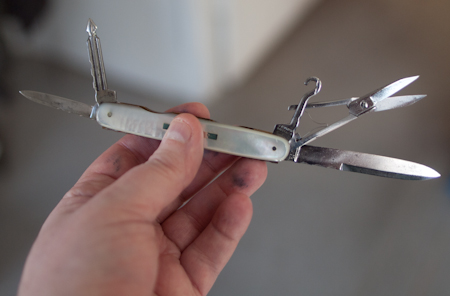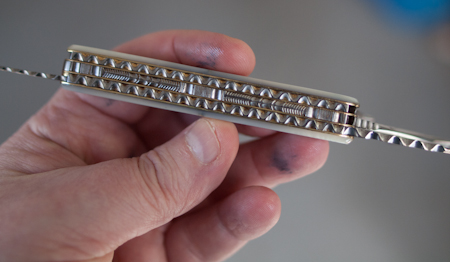|
|
|
 Joel's Blog Joel's Blog |
 Built-It Blog Built-It Blog |
 Video Roundup Video Roundup |
 Classes & Events Classes & Events |
 Work Magazine Work Magazine |
| Newer Entries... | |
 | Lifts and Separates - 05/03/2011 |
 | The Best Book On Tool Collecting EVER - 04/28/2011 |
 | Norris Plane Collecting.(Part Whatever) - 04/26/2011 |
 | An Unusual Old Saw - 04/19/2011 |
 | Which Festool Sander Should I Get? - 04/14/2011 |
 | Marquetry And Inlay On The Cheap - 04/12/2011 |
 | Chris Pye's Great Idea - 04/07/2011 |
 | Burning Desire (Not!) - 04/05/2011 |
 | The Victorian Pocketknife - 03/29/2011 |
 | Tools as Art - 2 - 03/22/2011 |
 | Do You Want My Job? - 03/17/2011 |
 | How To Saw Straight - 03/15/2011 |
 | A Boyhood Dream Fulfilled - 03/08/2011 |
 | Tool Test: Which Glue is Better - Epoxy, Yellow Wood Glue, or Liquid Hide Glue - 03/01/2011 |
 | Festool New Tools and Price Increases March 1, 2011 - 02/25/2011 |
 | How to Quickly Center A Mortise Or Find The Center Of A Board Without Gadgetry - 02/22/2011 |
 | A New Blog - Introducting Ben Seltzer - 02/17/2011 |
 | A Toolbox is Missing!! - 02/15/2011 |
 | Bench-on-Bench - 02/10/2011 |
 | Ron Hock Is Laughing At Me Right Now - 02/08/2011 |
| Older Entries... | |
|
Hours: M-F 9:00-5:00, closed Sat,Sun Our Guarantee & Return Policy Shipping and Sales Tax Info Privacy Policy Holiday Calendar |
|
Contact Us:
Email: support@toolsforworkingwood.com Phone: 800-426-4613 or 718-499-5877 Visit Us in Brooklyn: Directions to Our Showroom © 1999-2019 toolsforworkingwood.com Powered by 01 Inc. Coded entirely in NYC |



 I'm a sucker for tools. All kinds of tools. I routinely carry a pocketknife with me because working in a warehouse it is incredibly handy to have. I use other pocketknives for slicing my sandwich and other stuff.
I'm a sucker for tools. All kinds of tools. I routinely carry a pocketknife with me because working in a warehouse it is incredibly handy to have. I use other pocketknives for slicing my sandwich and other stuff.  What a really want to call your attention to is the decorative metalwork. The brass liners (which separate the blades) have decorative mill marks. The back and blades are covered with "file work" where decorative patterns are filed into the springs and blades in a pattern. The trick is making everything line up properly when the knife is assembled. There are many styles of filework and this type of knife is known as a "workback" because of the file work on the back.
What a really want to call your attention to is the decorative metalwork. The brass liners (which separate the blades) have decorative mill marks. The back and blades are covered with "file work" where decorative patterns are filed into the springs and blades in a pattern. The trick is making everything line up properly when the knife is assembled. There are many styles of filework and this type of knife is known as a "workback" because of the file work on the back.
I have always taken for granted that the button hook (as it is commonly called on the message boards that I used to frequent) was used for pulling buttons through the tiny button holes of the era. I hadn't considered that it might also be used for laces.
I appreciate seeing this post, and thank you for sharing that beautiful knife.
I have purchased two exceptional pocketknives from TFWW made by Queen that have D-2 blades and I am convinced that D-2 keeps it's edge longer than any other knife steel with which I am familiar...
I must admit I am not that great at sharpening a knife. Some times I can put a razor edge on in a few minutes and other times I could work forever and not be any sharper them when I started.
You won't know that you need one until you forget to put in your pocket after having carried it for a while.
Very nice article on knives. Of course as a boy in the late 1950's to the mid 60's I carried a pocket knife. Through the 70's I carried several wonderful little pocket knives and jack knives when Schrade Cutlery and Case still made carbon steel pocket knives and alas they were all lost because I didn't have a sheath. I do have a wonderful 1930's Schrade carpenters knife that I only carry in a sheath. Settled for a cheap SS Schrade. When I took up serious wood carving I found that J.A. Henckels-a Congress style and recently a Queen Cutlery-Oar Carver (O-1) tool steel and I did have a very nice SOG VG-10. The steel is critical to a properly functioning knife and then developing the sharpening skills. Please try to carry working knives.